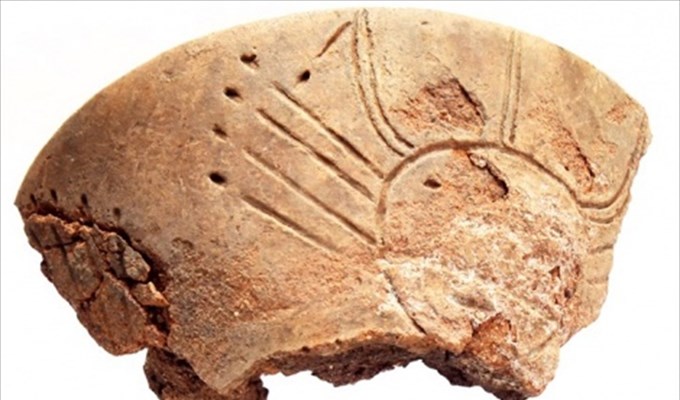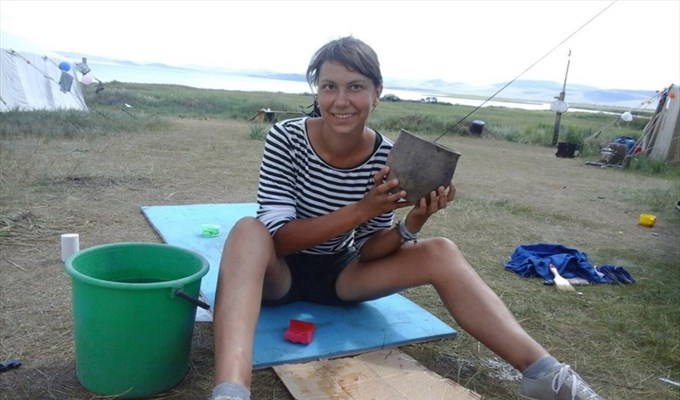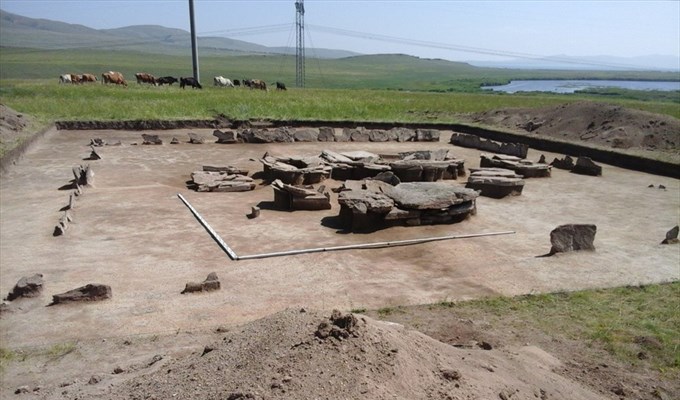TOMSK, Aug 15 – RIA Tomsk. Archaeological expedition
with participation of volunteers graduates of Tomsk State University (TSU) made
a unique find in Khakassia: experts found a ritual bowl with images of
so-called "solar masks" which found before only in a type of rock
paintings, is reported on Monday on the website of the university.
It is specified that graduates of department of
geography Elizabeth Ermolenko and Yaroslav Vyatkin participated in the
expedition organized by the Institute of History of Material Culture (IHMC) of
the Russian Academy of Sciences and the Russian Geographical Society (RGS). In
July and August archeologists investigated on the lake Itkul (Khakassia) three
barrows containing 12 burials (the III-II millennium B.C.).
The first evidence
As it is reported on RGS website, on excavation of a
burial ground the ritual censer bowl was found. This plaster vessel for burning
of fragrant herbs will for the first time allow to date the whole layer of the
ancient fine arts of Southern Siberia. The find is decorated with the images of
the so-called "solar masks".
"The Okunev archaeological culture is a unique
phenomenon of an era of early bronze of Southern Siberia. It left huge layer of
art heritage in the form of numerous images on stones – so-called masks.
However their communication with funeral monuments long time hasn't been
proved. Before only one case of the vessel fragment detection where the part of
a mask remained was known", – is said in the message.
© с сайта Русского географического общества
Censer of the Okunev Culture with the "mask"
It is emphasized that thanks to the conducted
researches it is possible to tell precisely that these images were made by
representatives of okunev culture.
Okunev culture – is the archaeological culture of an
early bronze age widespread in the Minusinsk steppes on Central Yenisei
(XXV-XVIII century B.C.). Its name it received on the natural boundary Okunev ulus
in the south of Khakassia where in 1928 the burial ground of this culture has
been for the first time dug out. Experts consider okunev culture as one of the
brightest cultures of an era of early bronze in all Northern Eurasia.
Ancient secrets
Archeologists found the censer during excavation of an
ancient necropolis, in the burial of the woman and child of okunev
archaeological culture which is almost not disturbed earlier. The unique find
is small in size – its height about 12 cm.
"Judging by rich accompanying inventory, the
woman held special position. Fortunately, this later burial in a barrow was not
noticed by robbers", – is reported on the RGS website.
In the same burial, except a censer, found a lot more
interesting finds: more than 100 suspension from the teeth of various animals,
including a musk deer, ritual objects from a bone and a horn, two vessels, two
needle cases with bone needles inside, a bronze knife and more than one and a
half thousand beads which sheathed clothes. Now employees of expedition should
string carefully beads on a special thin scaffold not to lose any bead.
© с сайта ТГУ
Participant of the expedition, TSU graduate Elizaveta Ermolenko
Excavation of a burial ground Itkol – is the part of
the IHMC RAS and the Russian Geographical Society "Secrets of Ancient
Artists of Siberia". Its task – is to expand a circle of scientific
knowledge about okunev culture and to acquaint volunteers of RGS with primitive
art of this culture.
"There are no cultures comparable to it with
wealth and a variety of art heritage in this region. Financing of the project
carries out by RGS which is also responsible for recruitment of volunteers for
expedition", – is said in the message.
During researches the find which allowed scientists to
make a hypothesis that representatives of okunev culture could be natives from
the territory of modern Kazakhstan was also made. This is indicated by a
stylized image of a bull, made in a rare manner.
"Style of the image of a bull with the extended
rectangular trunk isn't typical for okunev archaeological culture. Possibly,
this drawing belongs to little studied period of formation of okunev culture.
The bull of such form points to communication with the territory located to the
south, lands of modern Kazakhstan, so, on the ways which okunev people have
come to Southern Siberia", – researchers consider.
© с сайта ТГУ
Archaeological expedition to Khakassia in which TSU graduates took part